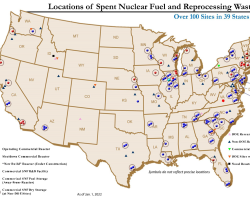Category of Content
Siting Experience Documents Only
Publication Date
Subject Matter
Keywords
Nuclear Fuels Storage and Transportation Planning Project Inventory Basis?, Rev 1
Nuclear Fuels Storage and Transportation Planning Project Inventory Basis?, Rev 1
Dry Storage Cask Inventory Assessment
Dry Storage Cask Inventory Assessment
United Nations Declaration on the Rights of Indigenous Peoples
United Nations Declaration on the Rights of Indigenous Peoples
The General Assembly, Taking note of the recommendation of the Human Rights Council contained in its resolution 1/2 of 29 June 20061 , by which the Council adopted the text of the United Nations Declaration on the Rights of Indigenous Peoples, Recalling its resolution 61/178 of 20 December 2006, by which it decided to defer consideration of and action on the Declaration to allow time for further consultations thereon, and also decided to conclude its consideration before the end of the sixty-first session of the General Assembly, 1 See Official Records of the General Assembly, Sixty-first S
U.S. Nuclear Plant Shutdowns, State Interventions, and Policy Concerns
U.S. Nuclear Plant Shutdowns, State Interventions, and Policy Concerns
The United States has the largest nuclear power plant fleet in the world, with 93 reactors that can generate approximately 95,522 megawatts (MW) of electricity. Nuclear power has accounted for about 20% of annual U.S. electricity generation since the late 1980s; in 2020 it was 19.7%. However, the U.S. nuclear power industry in recent years has been facing economic and financial challenges, particularly plants located in competitive power markets where natural gas and renewable power generators influence wholesale electricity prices. Twelve U.S.
Transportation Planning: Indigenous Dialogue
Transportation Planning: Indigenous Dialogue
In 2019, the NWMO commissioned Maawandoon Inc to lead Indigenous Dialogue session to support NWMO’s transportation planning for the long-term care of Canada’s used nuclear fuel. This research built upon and complemented public attitude research carried out in 2017 and 2018. The research methodology consisted of 7 Indigenous dialogue sessions and attendance at 3 Indigenous Annual General Assemblies (AGA)/meetings with dialogue components.
Topical Analysis of Nuclear Experts' Perceptions of Publics, Nuclear Energy, and Sustainable Futures
Topical Analysis of Nuclear Experts' Perceptions of Publics, Nuclear Energy, and Sustainable Futures
Nuclear energy experts consider commercial power from fission to be a strong contender to help mitigate the increasing effects of climate change, in part due to its low-to-no carbon emissions. Nevertheless, nuclear energy's history, including meltdowns such as Three Mile Island, Chernobyl, and Fukushima, and dumping in sacred Indigenous land such as Yucca Mountain, raises important concerns in public deliberation over nuclear power.
Survey of National Programs for Managing High-Level Radioactive Waste and Spent Nuclear Fuel: 2022 Update
Survey of National Programs for Managing High-Level Radioactive Waste and Spent Nuclear Fuel: 2022 Update
In October 2009, the U.S. Nuclear Waste Technical Review Board (Board or NWTRB) published Survey of National Programs for Managing High-Level Radioactive Waste and Spent Nuclear Fuel. For each of the 13 national programs studied, the report catalogued 15 institutional arrangements that had been set in place and 15 technical approaches that had been taken to design repository systems for the long-term management of high-activity radioactive waste.
Spent Nuclear Fuel and Reprocessing Waste Inventory, Revision 9
Spent Nuclear Fuel and Reprocessing Waste Inventory, Revision 9
This report provides information on the inventory of spent nuclear fuel (SNF) in the United States located at Nuclear Power Reactor and Independent Spent Fuel Storage Installation sites, as well as SNF and reprocessing waste located at U.S. Department of Energy sites and other research and development centers as of the end of calendar year 2021.
Status and Trends in Spent Fuel and Radioactive Waste Management
Status and Trends in Spent Fuel and Radioactive Waste Management
Status and Trends in Spent Fuel and Radioactive Waste Management is a collaborative project between the IAEA, the European Commission and the OECD Nuclear Energy Agency, with the participation of nuclear industry organization the World Nuclear Association, that aims to consolidate and complement the information gathered from different initiatives around the world.
Dry Storage Cask Inventory Assessment, Revision 2
Dry Storage Cask Inventory Assessment, Revision 2
The report, Commercial Spent Nuclear Fuel and High-Level Radioactive Waste Inventory Report(FCRDNFST- 2013-000263, Rev.4), provides information on the inventory of commercial spent fuel, referred to in this report as used nuclear fuel (UNF), as well as Government-owned UNF and High Level Waste (HLW) in the U.S. Department of Energy (DOE) complex. Inventory forecasts for commercial UNF were made for a few selected scenarios of future commercial nuclear power generation involving the existing reactor fleet including one scenario involving reactors under construction.




